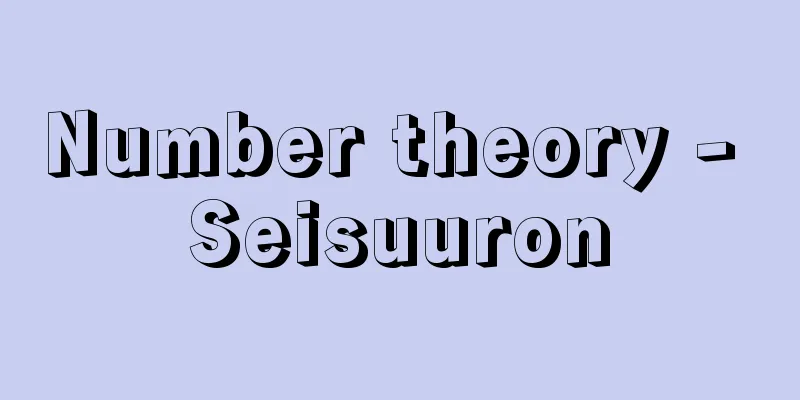Number theory - Seisuuron

|
The branch of mathematics concerned with the study of integers. Ancient Number TheoryThe natural number solutions of the indeterminate equation x2 + y2 = z2 are called Pythagorean triples. There is sufficient evidence to suggest that the method for finding all Pythagorean triples was known in Babylonia around 2000 BC, long before Pythagoras. This also means that mathematics was a subject of intellectual inquiry separate from practical use from a fairly early period. Books 7 to 9 of Euclid's Stoichia, which can be said to be the culmination of Greek mathematics, deal with number theory. Here are some of the most famous propositions in the book. (1) Prime factorization and its uniqueness. (2) Euclidean algorithm: A method for finding the greatest common divisor. (3) Euclid's Prime Number Theorem: A proof by contradiction that there is no limit to the number of prime numbers. (4) If 2 n -1 is a prime number, then a = 2 n -1 (2 n -1) is a perfect number, that is, the sum of the divisors of a is 2a . The inverse of (4), that is, that even perfect numbers can be expressed in the above form, was later proven by Euler. The existence of odd perfect numbers is not yet known. Furthermore, Diophantus's "Theory of Numbers" cannot be overlooked among Greek mathematics, which has a strong geometrical color. As well as dealing with rational number solutions to indeterminate equations, expressing unknowns in letters was also an important achievement. [Tsuneo Adachi] Modern Number Theory In medieval Europe, number theory did not take on the formality of an academic field, but Greek classics were preserved in Arabia and a certain amount of research was conducted on it. After the Renaissance, Greek classics began to be translated into Latin, among which was a long-obscured translation of Diophantus's Arithmetic by Claude Gaspard Bachet de Méziriac (1581-1638). Fermat is known as the founder of probability theory and a researcher of analytical geometric methods, but what sets him apart from his contemporaries (Pascal, Descartes, etc.) is his particular love of number theory, and for this reason he is known as the founder of modern number theory. Some of Fermat's achievements are as follows: (2) A prime number p , where p ≡ 1 (mod 4), can be expressed as the sum of two square numbers. (3) Study of the Pell equation x2 - Ay2 = 1. Fermat left behind almost no proofs, but most of the propositions he stated have now been proven. The truth of the proposition known as Fermat's Conjecture, which he said he came up with from a description of Pythagorean numbers in Diophantus's "Theory of Numbers," remained unclear for a long time, but in 1994, about 360 years after Fermat raised the issue, Princeton University professor Andrew Wiles (1953- ) completed the proof, and in 1995 the proof was confirmed to be correct. Stated in modern notation, the proposition is: xn + yn = zn when n is a natural number greater than or equal to 3 . The mathematician who made the greatest contribution to number theory after Fermat was Euler. Euler proved that Fermat's theorem is correct when n is 3. Euler also provided a proof for the proposition that prime numbers of the form 4 n + 1, as stated by Fermat, can be expressed as a sum of squares. [Tsuneo Adachi] Modern Number Theory Modern number theory was founded by Gauss. Some results from his Disquisitiones Arithmeticae (1801): (2) Prime factorization of natural numbers and a rigorous proof of its uniqueness. (3) Introduction of Gaussian integers and research into their fundamental properties Complex numbers of the form x + iy ( x and y are integers) are called Gaussian integers. He defined the divisibility of Gaussian integers and proved the uniqueness of prime factorization. This became the starting point of later algebraic number theory. (4) Reciprocity of Quadratic ResiduesLet a and b be mutually prime integers, then a is a quadratic residue modulo b if there exists an integer x such that a ≡ x 2 (mod b ).
(5) Completion of the study of two - dimensional quadratic forms : ax2 + bxy + cy2 = d ( a , b , c , d are integers) Dirichlet is said to have always carried Gauss's Discourses on Arithmetic with him and studied them. Dirichlet's main achievement in number theory was the introduction of analytical methods. For example, he proved the theorem (the arithmetic progression theorem) which asserts that in an arithmetic progression whose first term and common difference are relatively prime, there are an infinite number of terms that are prime numbers. Analytical number theory subsequently developed, and in 1896 Hadamard and Ch. de la Vallée-Poussin proved the prime number theorem conjectured by Gauss using deep results in the theory of complex functions. Complex number theory, which began with Gauss, made a leap forward with Kummer's research into Fermat's conjecture, and developed into the current algebraic number theory. Kummer, who was clearly aware that there were cases in which the uniqueness of prime factorization did not hold, introduced the concept of ideal numbers in cyclotomic fields to restore uniqueness. Ideal numbers, a concept that is now called factor theory, were given the entity of ideals by Dedekind. Ideals are thought to be the first time that set theory was consciously used in mathematics. Algebraic number theory, in which ideal theory and Galois' theory were combined and given a place to play, was organized by Hilbert, opening the way for Teiji Takagi's class field theory. In addition to algebraic number theory and analytical number theory, as mentioned above, there are also studies using geometric methods, research specific to the theory of indeterminate equations, and research based on the foundations of mathematics, which has been a hot topic since the 1960s. Let us state Siegel's finiteness theorem, one of the most brilliant achievements in the theory of indeterminate equations. Let f ( x , y ) be a polynomial with integer coefficients, On the other hand, Hilbert posed the problem of finding a general algorithm for determining whether an indeterminate equation has a solution (Hilbert's Problem 10), but according to Yuri Matijasevic, such an algorithm does not exist (proof in 1970). This problem uses foundational methods including the idea of recursive functions, and it had a major impact on the mathematical world. A certain amount of development is expected in this field as well. [Tsuneo Adachi] [References] | | | | |Source: Shogakukan Encyclopedia Nipponica About Encyclopedia Nipponica Information | Legend |
|
整数についての研究を対象とする数学の学問領域。 古代の整数論不定方程式x2+y2=z2の自然数解をピタゴラス数という。すべてのピタゴラス数を求める方法が、ピタゴラスをはるかにさかのぼる紀元前2000年近いころにバビロニアで知られていたことを推測させる十分な証拠がある。そのことはまた、数学が、かなり早い時期から実用を離れた知的探究の対象となっていたことをも意味するであろう。 ギリシア数学の総決算ともいえるユークリッドの『ストイケイア』の第7巻から第9巻には整数論が扱われている。そのなかでも有名な命題をいくつか拾ってみる。 (1)素因数分解とその一意性。 (2)ユークリッドの互除法 最大公約数を求める計算法。 (3)ユークリッドの素数定理 素数の個数には限りがないことの背理法による証明。 (4)2n-1が素数ならばa=2n-1(2n-1)は完全数、つまりaの約数の和が2aである。 この(4)の逆、すなわち偶数の完全数が前記の形に表せることは、のちにオイラーによって証明された。奇数の完全数の存在はまだ知られていない。なお、幾何学的色彩の強いギリシア数学のなかでディオファントスの『数論』を落とすことはできない。不定方程式の有理数解を扱ったこととともに、未知数を文字で表したことも重要な業績である。 [足立恒雄] 近世の整数論中世ヨーロッパにおいては整数論は学問としての体裁を整えなかったが、アラビアにおいてギリシアの古典が保存され、一定の研究がなされていた。文芸復興期以後ギリシア古典のラテン語への翻訳がされるようになったが、そのなかに、長らく埋もれていたディオファントスの『算術』のバシェClaude Gaspard Bachet de Méziriac(1581―1638)による翻訳があった。フェルマーは確率論の始祖、解析幾何的手法の研究者として知られるが、なかでも他の同時代の人たち(パスカル、デカルトら)と際だった対照をみせるのは、整数論に対する格別の愛好であり、したがってフェルマーは近代的整数論の始祖とよばれている。フェルマーの業績の一部を述べてみると (2)p≡1(mod4)なる素数pは二つの平方数の和として表せる。 (3)ペル方程式x2-Ay2=1の研究。 などである。フェルマーは証明をほとんど残さなかったが、その言明した命題の大半は現在証明が得られている。ディオファントスの『数論』のピタゴラス数に関する記述から思い付いたという、フェルマーの予想とよばれた命題は、長くその真偽がわからなかったが、フェルマーがこの問題を提起してから約360年後の1994年、プリンストン大学教授のワイルズAndrew Wiles(1953― )によって問題の証明が完成され、1995年にその証明が正しいことが確認された。その命題を現在の記法で述べると、nが3以上の自然数であるとき フェルマーに続く時代の整数論にもっとも大きな貢献をした数学者はオイラーである。オイラーは、nが3の場合にフェルマーの定理が正しいことを証明した。またフェルマーの言明した前記の4n+1の形をした素数が平方和に表せるという命題も、オイラーが証明を与えた。 [足立恒雄] 近代の整数論近代の整数論はガウスによって基礎づけられた。1801年刊行の『数論講究』Disquisitiones Arithmeticaeからいくつかの結果を拾ってみると (2)自然数の素因数分解とその一意性の厳密な証明。 (3)ガウスの整数の導入とその基本的性質の研究 x+iy(x、yは整数)の形の複素数をガウスの整数という。ガウスの整数の整除を定義し、素因数分解の一意性を証明した。これは後の代数的整数論の出発点となった。 (4)平方剰余の相互律 a、bを互いに素な整数とするとき、aが法bの平方剰余であるとは、a≡x2(modb)を満たす整数xが存在するときである。このとき
(5)二元二次形式の研究の完成 ディリクレはガウスの『数論講究』を常時携帯し研究したといわれる。ディリクレの整数論上のおもな業績は解析的手法の導入である。たとえば、初項と公差が互いに素な等差数列中には素数となる項が無数にあることを主張する定理(算術級数定理)は彼によって証明された。その後、解析的整数論は発展を遂げて、1896年にはアダマールとド・ラ・バレ・プーサンCh. de la Vallée-Poussinによりガウスの予想した素数定理が複素関数論の深い結果を用いて証明された。 ガウスに始まる複素整数論はクンマーによるフェルマーの予想の研究によって飛躍を遂げ、現今の代数的整数論へと発展した。素因数分解の一意性が成り立たない場合があることを明確に意識していたクンマーは、円分体において理想数という概念を導入して一意性の回復をした。現今の用語では因子論とよばれる概念である理想数は、デーデキントによってイデアルという実体を与えられた。イデアルは集合論が意識的な形で数学に使用された最初ではないかと思われる。イデアル論とガロアの理論が結合して活躍の場を与えられた形の代数的整数論はヒルベルトによって整理され、高木貞治(たかぎていじ)の類体論へと道が開かれたのである。整数論はいままで述べたように代数的整数論、解析的整数論のほかに、幾何学的手法を用いる研究、不定方程式論固有の研究、また1960年代以降話題になりつつある数学基礎論による研究などがある。 不定方程式論におけるもっとも輝かしい成果の一つであるジーゲルの有限性定理を述べておく。f(x, y)を整数係数の多項式とし、 一方、ヒルベルトは、不定方程式が解を有するかどうかを判定する一般的なアルゴリズムを求めよという問題(ヒルベルトの第10問題)を提起したが、マチャセビチYuri Matijasevicによれば、そういうアルゴリズムは存在しない(証明1970年)。これには帰納的関数の考えをはじめとする基礎論的手法が用いられており、数学界に大きな衝撃を与えた。この分野も一定の発展が期待されるであろう。 [足立恒雄] [参照項目] | | | | |出典 小学館 日本大百科全書(ニッポニカ)日本大百科全書(ニッポニカ)について 情報 | 凡例 |
<<: Drafting tools - Seizuyogu
Recommend
Tran Hung Dao
?-1300? A Vietnamese national hero who defeated th...
Sanjo Sanefusa
1147-1225 A court noble from the late Heian to Ka...
self-heal
...It also has a blood pressure lowering effect. ...
Climate change
Climate changes over long periods of time. Glacia...
Cyrtomium falcatum
…[Shigeyuki Mitsuda]. … *Some of the terminology ...
Aurora Chorus
...Similar radio waves are also observed by artif...
Gold rice cake - Kinpei
…On the other hand, in the southern territory of ...
Varus, PQ (English spelling) VarusPQ
…In AD 9, in the Teutoburg Forest (the exact loca...
Iyo [city] - Iyo
A city in central Ehime Prefecture facing the Iyo ...
Nasi script (Nasi script) - Nasi characters
A script that has been used since ancient times by...
Satin (English spelling)
The name of a fabric weave. In Japanese, it is cal...
singing sand
...However, the future of sand supply to meet dem...
Kashima Port - Kashimako
An excavated harbor in the southeast of Ibaraki Pr...
Flesh fly - flesh fly
A general term for insects belonging to the family...
Orizume-dake
A mountain located in the northern part of Iwate ...









